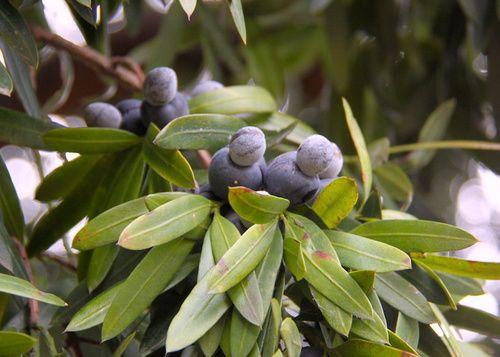Il Plum pine is a plum-like fruit native to Australia. Strong in power antioxidant, is useful for the gastrointestinal tract, the skin and the joints. Let's find out better.
> Nutritional composition and properties of Plum pine
> Contraindications of Plum pine
> How to eat Plum pine

Description of the fruit
Australia offers us a little-known fruit with a rather unusual appearance: it is the plum pine, reported in some texts and villages as Illawarra plum. It is the Podocarpus elatus, an ancient conifer, of which there are traces of fossils dating back to more than two hundred million years ago.
It produces a fruit apparently similar to a plum dark covered with plum but has the characteristic of being "double": each plum pine resembles two attached prunes, one of which, the smallest, contains a long seed.
The pulp is fleshy as that of a plum could be but the flavor is very resinous, sometimes excessively intense for those who have never tried it; it is not for nothing that the name plum pine means "pine cone-plum". For centuries it has been instrumental in the diet and medicine of Aboriginal people in the Illwarra areas, where other types of fruit are very scarce.
Plum pine, ally of
Gastrointestinal tract, skin, joints. Protects DNA and cells.
Nutritional composition and properties of plum pine
The plum pine is a fruit with distinct antioxidant properties, calculated as seven times more effective than those of blueberry, and evident at first glance given the blue of the skin and the purple of the pulp; its particular sugars have the ability to adhere to the mucous membrane of the gastrointestinal tract, protecting it and helping it to repair itself, as mucilage would do.
Recently, many US and Australian studies have highlighted the cantiproliferative apacity of plum pine with respect to tumor cells (especially in the case of colon cancer), and they are studying treatments based on plum pine extracts to develop a series of alternative strategies to chemotherapy and other conventional cancer treatments that are often very invasive.
This is mainly due to the results of laboratory analyzes which attribute to plum pine antiproliferative and pro-apoptopic properties, that is, capable of inducing a process of autophagy thanks to which the "bad" cells kill themselves. In addition, thanks to the ability to inhibit telomerase, it also acts as an antimutagen.
Contraindications of plum pine
There are currently no known contraindications regarding the consumption of plum pine. Apart from the strong flavor that resembles the resin of pine cones and which can repel some people, it is advisable to limit the consumption of this fruit, as has always been done by the Aborigines who use it sparingly, as a food supplement.
Curiosity
- At first the settlers used most of the plum pine plants for the precious qualities of wood, culling a huge number of them and risking the extinction of the species.
- In the panorama of the conifer phylum, plum pine is probably the only edible fruit.
How to eat plum pine
Australian Aborigines have been eating for millennia the fresh plum pine fruits, freshly harvested, but upon their arrival the settlers tried to prepare them in many ways, often with success. Therefore the fruit is mostly used to prepare juices, jams and preserves, to flavor sweets and chocolate, and also to prepare sweet and sour dishes and chutneys, given its ability to blend perfectly with garlic and chilli, giving you a resinous aroma that cannot be found elsewhere in the kitchen. Overcooking makes the fruit excessively bitter and unsuitable for use.
READ MORE
The properties and contraindications of the Pineberry fruit
In collaboration with Giacomo Colomba
| Parramattahistorical.org.au


























